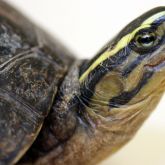South-East Asian box turtle
Alert
Have you seen South-East Asian box turtle?
Be on the lookout for South-East Asian box turtle and report it to Biosecurity Queensland. Early detection and reporting are the key elements in preventing South-East Asian box turtles from becoming a major problem in Queensland.
Call us on 13 25 23.

South East Asian box turtle head close-up
© Queensland Government

South East Asian box turtle shell
© Queensland Government

South East Asian box hinge
© Queensland Government

South East Asian box turtle
© Queensland Government
Native to South-East Asia, the South-East Asian box turtle is a brown turtle with a domed upper shell and a hinged lower shell. Its natural range extends from mainland Indochina, Malaysia and Borneo to Thailand and Singapore.
Although it is classified as vulnerable by the International Union for Conservation of Nature (due to its exploitation for the international food, pet, and medicine trade), the South-East Asian box turtle is still relatively common in most of its range. This may be because it can live in many natural and artificial habitats, including rice fields and near human settlements.
The South-East Asian box turtle has not established itself in Australia, but if introduced, it would compete with native turtles for food and space. To prevent South-East Asian box turtles from establishing in Queensland, restrictions apply to their import, possession and sale.
You must not keep, feed, move, give away, sell or release into the environment. Penalties may apply.
You must report all sightings to Biosecurity Queensland within 24 hours.
Scientific name
Similar species
- Cuora amboinensis amboinensis (Wallacean box turtle)
- Cuora amboinensis couro (West Indonesian box turtle)
- Cuora amboinensis lineata (Burmese box turtle)
- other species of box turtle found in the USA and Mexico (Genus Terrapene).
Description
- Freshwater turtle up to 25cm long.
- Upper shell is highly domed, lower shell is hinged so that the turtle can close its shell almost completely.
- Upper shell is blackish-brown to olive brown, lower shell is yellow, cream or pale brown, with or without dark blotches.
- Head is blackish-olive with 3 distinct yellow stripes on the side.
- Head can withdraw completely into the shell (unlike native Australian turtles).
Habitat
- Adapts to and occupies a wide variety of natural and artificial wetlands in tropical rainforest areas.
- Habitats include marshes, creeks, swamps, ponds, permanent or temporary wetlands, shallow lakes, flooded rice fields, irrigation ditches, canals, ponds, and pools near houses or nearby these areas.
- Juveniles are mostly aquatic.
- Adults are semi-aquatic and spend more time on land.
- Can move rapidly on land and be found quite far from water.
Distribution
- Detected as an escaped illegal pet in Brisbane.
- Not currently known to exist in the wild in Queensland.
Life cycle
- Average life span is 25–30 years.
- Slow reproductive cycle characterised by late maturity and a limited number of eggs.
- Reaches sexual maturity after 4–5 years (when carapace is 130mm long for males and 152mm long for females).
- Females lay 1–4 eggs per clutch and can lay several clutches per year. Can lay fertile eggs for up to 4 years after a single successful mating.
- Survival rate of hatchlings is reportedly very low; hatchlings (and eggs) are an important food source for monitor lizards, herons and some small mammals.
Affected animals
- Native turtles
- Native aquatic animals
Impacts
Environmental
- Eats a wide range of aquatic prey, including snails, insects, berries, fungi, slugs, worms, roots, flowers, fish, frogs, salamanders, snakes, birds, and eggs. Has also been observed eating carrion.
- Younger turtles are primarily carnivorous, while adults tend to be mostly herbivorous.
- Competes with native turtle species for food and waterway space.
- Popular pet species, possibly traded through an illegal pet market.
Economic
- Popular pet species, possibly traded through an illegal pet market.
- Used in Asian medicine overseas.
Control
If you see or are in possession of a South-East Asian box turtle, please contact our Customer Service Centre within 24 hours.
Legal requirements
- The South-East Asian box turtle is a prohibited invasive animal under the Biosecurity Act 2014.
- You must not keep, feed, move, give away, sell or release into the environment. Penalties may apply.
- You must not take any action reasonably likely to exacerbate the biosecurity threat posed by the South-East Asian box turtle.
- You must take any action that is reasonably likely to minimise the biosecurity threat posed by the South-East Asian box turtle. You must report all sightings to Biosecurity Queensland within 24 hours.